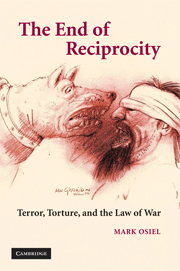Book contents
- Frontmatter
- Contents
- Introduction
- PART ONE RECIPROCITY IN HUMANITARIAN LAW
- PART TWO THE ETHICS OF TORTURE AS RECIPROCITY
- 4 Is Torture Uniquely Degrading? The Unpersuasive Answer of Liberal Jurisprudence
- 5 Fairness in Terrorist War (1): Rawlsian Reciprocity
- 6 Fairness in Terrorist War (2): Kantian Reciprocity
- 7 Humanitarian Law as Corrective Justice: Do Targeted Killing and Torture “Correct” for Terror?
- PART THREE RECIPROCITY IN THE SOCIAL SCIENCE OF WAR
- PART FOUR THE END OF RECIPROCITY
- Conclusion
- Acknowledgments
- Notes
- Index
7 - Humanitarian Law as Corrective Justice: Do Targeted Killing and Torture “Correct” for Terror?
Published online by Cambridge University Press: 05 June 2012
- Frontmatter
- Contents
- Introduction
- PART ONE RECIPROCITY IN HUMANITARIAN LAW
- PART TWO THE ETHICS OF TORTURE AS RECIPROCITY
- 4 Is Torture Uniquely Degrading? The Unpersuasive Answer of Liberal Jurisprudence
- 5 Fairness in Terrorist War (1): Rawlsian Reciprocity
- 6 Fairness in Terrorist War (2): Kantian Reciprocity
- 7 Humanitarian Law as Corrective Justice: Do Targeted Killing and Torture “Correct” for Terror?
- PART THREE RECIPROCITY IN THE SOCIAL SCIENCE OF WAR
- PART FOUR THE END OF RECIPROCITY
- Conclusion
- Acknowledgments
- Notes
- Index
Summary
A FAIR FIGHT IS A MEANINGFUL AIM, DESPITE RESOURCE DISPARITY
Some would say that, if the Geneva and Hague Conventions harbor any implicit conception of a fair fight, it must surely be quite thin, for they have never required equality of arms. These treaties and related customary law have always permitted vast disparities in resources between military antagonists – and the consequent disparities in human suffering. That a superpower's superior matériel lets it impose certain asymmetrical risks on its foes – for example, much weaker roguish states and terrorist networks – is normatively irrelevant, according to the law of war.
The type of reciprocity enshrined in humanitarian law is also compatible with the violent subordination of one belligerent by the other, which often results at least partly from resource disparities. To be lawful, such domination need only be effected without recourse to genocide, crimes against humanity, war crimes, and violations of the law of military occupation. The law aims to accommodate “realism” to this extent, in that it does not actively interfere with more obvious forms of military domination. If it chose to, a more demanding understanding of reciprocity would be a good way to do so. Of course, other moral systems throughout history, including even the sexual ethics of the ancient Greeks, set similar limitations on their ambitions, and so too on the scope of reciprocity, as a means of reconciling with the most entrenched features of existing power relations.
- Type
- Chapter
- Information
- The End of ReciprocityTerror, Torture, and the Law of War, pp. 195 - 218Publisher: Cambridge University PressPrint publication year: 2009

